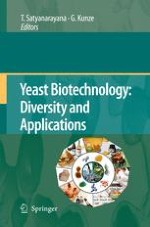2009 | OriginalPaper | Chapter
Basidiomycetous Yeasts: Current Status
Authors : Devendra K. Choudhary, Bhavdish N. Johri
Published in: Yeast Biotechnology: Diversity and Applications
Publisher: Springer Netherlands
Activate our intelligent search to find suitable subject content or patents.
Select sections of text to find matching patents with Artificial Intelligence. powered by
Select sections of text to find additional relevant content using AI-assisted search. powered by
The approach to yeast identification has significantly changed in just a few decades due to rapid increase in basic biological knowledge, increased interest in the practical applications and biodiversity of this important microbial group, and enormous technological advances especially in the sphere of molecular tools. While some conventional methods are still tenable, many molecular techniques have been developed that allow for strain classification at all taxonomic levels. However, the oldest tool of microbiology, the microscope, is still a fundamental accessory for studies involving yeast biology, biodiversity and taxonomy
The basidiomycetous yeasts, are currently recognized, in three classes of the Basidiomycota: Ustilaginomycetes, Urediniomycetes and Hymenomycetes. These yeasts have considerable economic, agricultural and medical importance and estimates suggest that the number of known yeasts represents only about 1 to 5 % of the species that exist in nature. There is an increased interest in exploration of these species for economic exploitation and there is a need to understand their biodiversity and ecological roles
Identification and phylogenetic placement of the basidiomycetous yeasts is not always easy, partly because of their polyphyletic nature. The unifying characteristic of these fungi is a predominant unicellular growth phase. Separation of yeasts into the three classes of fungi is based on septal morphology, cell wall composition and rDNA analysis. Generic diagnosis is based on sexual and vegetative biology, in addition to physiological tests such as growth on inositol or D-glucuronic acid and formation of extracellular starch-like compounds. Species are usually differentiated by physiological attributes, particularly the utilization of carbon and nitrogen sources, and by measurement of DNA reassociations between closely related species. Currently approximately 50 genera and 250 species of basidiomycetous yeasts are known. Molecular methods used in their identification include, species-specific PCR primers, analysis of RFLPs PFGE, randomly amplified polymorphic DNA (RAPD) and single-stranded conformational polymorphisms (SSCP). Significant advances in basidiomycete systematics have resulted from sequence analysis of the large and small subunits of rDNA.
Basidiomycetous yeast species are associated with living plants,
viz., Sporobolomyces
and
Phaffia
. Several species have been found to play a prominent role in biocontrol of plant disease whereas others have application in agro based industry. For example,
Phaffia rhodozyma
produces a pigment astaxanthin that has considerable market in aquaculture industry. On the other hand several species produce polysaccharases and can store lipids in amounts reaching upto 65 % of their biomass. Some species of
Cryptococcus, Rhodotorula
and
Trichosporon
can degrade varied aromatic compounds and thus are a candidate in bioremediation. On the negative side is the pathogenic
Filobasidiella neoformans
that poses medical problem since both the varieties of this basidiomycetous yeast infect the lungs which can result in pneumococcal-type pneumonia. Lipophilic
Malassezia
spp. are associated with skin surfaces but can cause serious pulmonary and other infections.
Diversity searches in the natural environment have resulted in description of new species within the basidiomycetous yeasts at a rapid pace and the field is wide open to global exploration.
